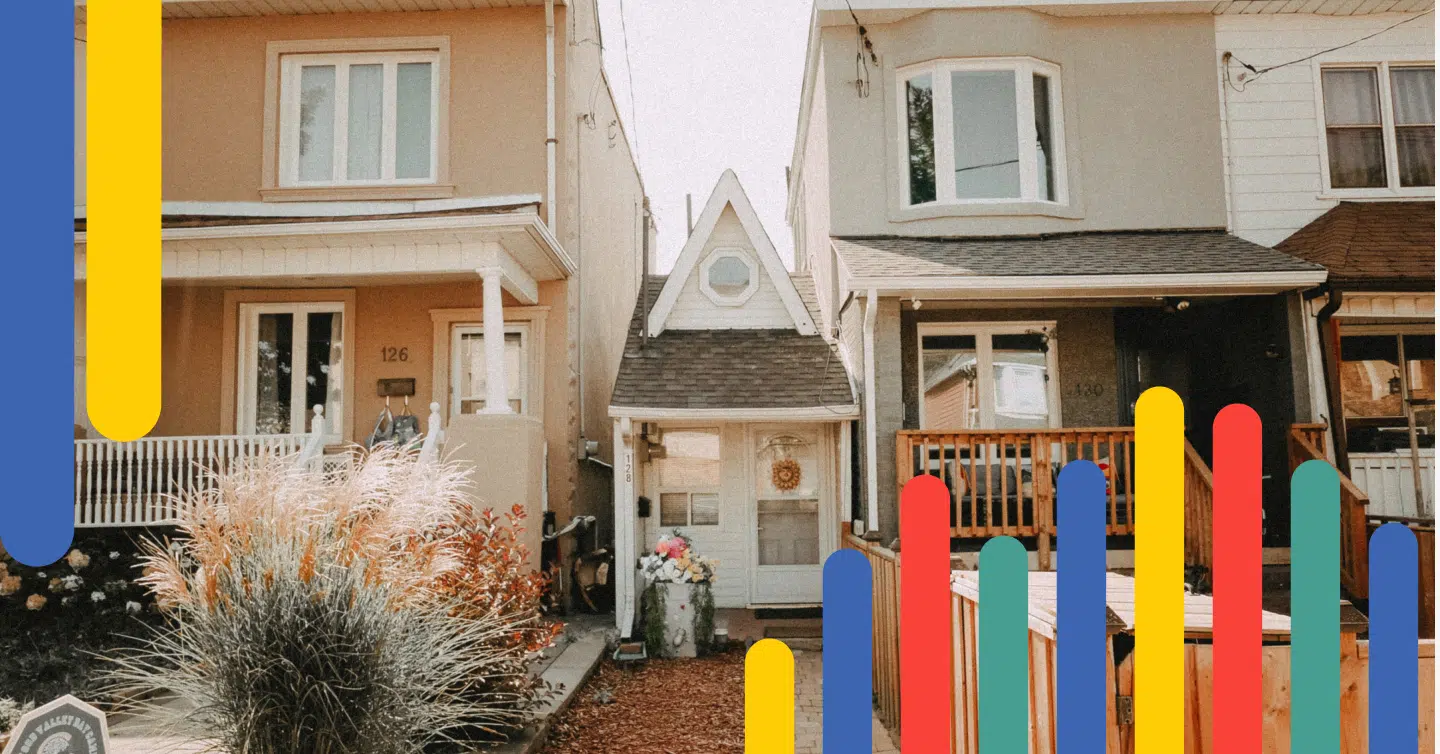Mortgage Basics #Featured articles
Mortgage Basics #Featured articles
Canada Mortgage Rate History

Table of contents
Housing is a significant financial investment for many Canadians, so it is vital to understand historical mortgage rates and their fluctuations over the years. The Bank of Canada’s (BoC) prime rate significantly impacts mortgage rates, influencing the interest lenders charge borrowers.
By examining the prime rate trends over time, you can gain better insight into the pattern rates follow and potentially predict future changes. This article will dive into historical interest rates in Canada, exploring how the prime rate has evolved and the significance of how these rates shape the housing market.
Key Highlights
- The Bank of Canada’s overnight rate was established in 1996 and directly influences the prime mortgage rates that banks and lenders offer.
- During the global oil crisis, the Bank of Canada rate reached a record high of 20.03% in 1981.
- The Bank of Canada policy rate reached record lows during the COVID-19 pandemic, dipping to 0.25%.
We’re curious…
Canada Mortgage Rates History (1975 to 2024)
The history of mortgage rates in Canada is a fascinating journey that significantly impacts the cost of homeownership, housing, and the economy as a whole. From the 1970s to the present, mortgage rates in Canada have been on a downward trend despite several peaks and troughs over the years. Rates have decreased from their peak of high double digits experienced in the 1980s during a period of high inflation and the global oil crisis to the historical lows experienced in 2020-2021 during the COVID-19 pandemic to where they currently sit in the mid-single digits today.
Source: bankofcanada.ca
The graph above displays the prime rate’s history since its introduction in 1935. The prime rate is the benchmark for all variable mortgages and lending products in Canada. Using this graph, you can see the many peaks and troughs that have occurred over the years and map out a pattern of how interest rates have gone up and down through the decades. Using the chart for the present day, you can see how we have approached another peak in the prime rate. Going forward, we will begin to see rates fall once again.
Average Posted Mortgage Rates for 1, 3, and 5-Year Terms
Who Historically Determines Mortgage Rates in Canada?
Established in 1935, the Bank of Canada (BoC) has been Canada’s main determinant of mortgage rates. The target for the overnight rate, also known as the policy interest rate, introduced in 1996, has been the main influencer on lenders’ setting their prime rates.
Lenders update their prime rates whenever the BoC updates the policy interest rate. Whenever the policy rate increases, lenders raise their prime rates. Whenever it decreases, lenders reduce their prime rates.
Why Do Historical Mortgage Rates Matter?
Historical mortgage rates are an indicator of past market conditions and can aid in predicting future changes. Mortgage rates significantly affect the cost of homeownership. Shelter costs comprise a significant portion of Canada’s Consumer Price Index (CPI) readings, with owned accommodations making up a substantial portion of this basket (17.96% of the total 28.34% weight).
In this BoC’s monetary policy tightening cycle round, shelter costs have kept Canada’s inflation rate high, preventing the Bank of Canada from considering rate cuts. The Bank must maintain the policy rate to control inflation and return it to its 2% target range.
Historical mortgage rate trends are essential when analyzing current market conditions and where they might be in the future. The pattern that emerges from analyzing past rates can show what to expect with rates today and how the predicted direction of rates in the future will affect borrowing costs over the next few years.
Posted Historical 5-Year Mortgage Rates (1950s – Present)
While 5-year fixed rates were once Canada’s most popular mortgage option, the pandemic saw a shift to variable rates as interest rates hit historic lows. Many borrowers are now moving to short-term fixed-rate mortgages, allowing them to possibly lock into lower rates once they come up for renewal.
The 5-year fixed-rate mortgage is an important economic indicator because 5-year government bond yields influence this fixed rate. 5-year bond yields are often used to measure the state of the Canadian economy.
Posted Historical 3-Year Mortgage Rates (2000 – 2024)
3-year fixed-rate mortgages have gained popularity recently as a way to ride out high interest rates as homeowners wait for rates to fall. This rate is most preferred during high interest climates like the one we are currently experiencing today.
As shown above, the 3-year fixed rate has fluctuated similarly to the Bank of Canada’s Prime Rate over the years. Since 3 years is a shorter term, banks and lenders typically post the 3-year fixed rate higher than 5-year rates. For this reason, some borrowers interested in a 3-year fixed-rate mortgage are often advised to consider variable and adjustable-rate mortgages, depending on personal preferences and financial circumstances.
Find a better rate, and we’ll match it, beat it, or give you $500*.
*Conditions Apply
With nesto, it’s stress-free
Historical Monthly Mortgage Payments
Over the decades, average monthly mortgage payments have fluctuated dramatically, reflecting changes in the housing market and the overall economy. During periods of high interest rates, mortgage payments are typically significantly higher, placing a financial strain on many homeowners. However, it’s important to note that the last time interest rates hit double digits, the average price of a home in Canada compared to household incomes made it much more affordable than it is today.
| Year | Average Home Price (Toronto) | Average Home Price Adjusted for Inflation in Today’s Dollars (Toronto) | Averaged 5-year Fixed Rate Interest Rate | Average Monthly Mortgage Payment | Average Monthly Mortgage Payment Adjusted for Inflation in Today’s Dollars |
|---|---|---|---|---|---|
| 1980 | $75,694 | $286,659.33 | 14.32% | $725 | $2,745.63 |
| 1985 | $109,094 | $279,895.95 | 12.18% | $911 | $2,337.30 |
| 1990 | $255,020 | $526,332.02 | 13.24% | $2,283 | $4,711.85 |
| 1995 | $200,220 | $265,991.06 | 9.22% | $1,349 | $2,465.90 |
| 2000 | $243,255 | $411,842.42 | 8.21% | $1,511 | $2,558.20 |
| 2005 | $335,907 | $504,977.00 | 5.48% | $1,637 | $2,460.94 |
| 2010 | $431,262 | $593,125.76 | 4.82% | $1,971 | $2,710.77 |
| 2015 | $622,116 | $792,284.50 | 3.77% | $2,555 | $3,253.87 |
| 2020 | $929,636 | $1,075,741.07 | 3.71% | $3,794 | $4,390.28 |
In 1980, the average monthly mortgage payment for the average-priced home would have been $725. Adjusted for inflation, that would be $2,745.63 in today’s dollars. The important part here is that adjusting the average price of a home from 1980 would be $286,659.33 in today’s dollars—not even enough to purchase the smallest studio condo in the city.
Monthly Mortgage Payments vs. Monthly Household Income
When comparing mortgage payments as a percentage of a household’s monthly income, it’s evident that mortgage affordability has decreased since the 1980s. A single salary in Toronto was enough for the average monthly mortgage payment to be only 27% of that income. Compare that figure to 2015 and 2020, where a single salary no longer supports the average monthly mortgage payment.
| Year | Average Monthly Mortgage Payment | Median After-Tax Monthly Income | Monthly Payment to Disposable Income Ratio |
|---|---|---|---|
| 1980 | $725 | $2,683.33 | 27.0% |
| 1985 | $911 | $2,625.00 | 34.7% |
| 1990 | $2,283 | $2,666.67 | 85.6% |
| 1995 | $1,349 | $2,583.33 | 52.2% |
| 2000 | $1,511 | $3,066.67 | 49.3% |
| 2005 | $1,637 | $2,966.67 | 55.2% |
| 2010 | $1,971 | $2,983.33 | 66.1% |
| 2015 | $2,555 | $2,525.00 | 101.2% |
| 2020 | $3,794 | $3,016.67 | 125.8% |
Chronological Dive into Mortgage Rate Trends
Here are some key historical moments in Canada’s economy that affected the Bank of Canada rate and housing in general.
Post-WWII Era: Baby Boomer Housing Demand
In light of Canada’s role in WWII as a key supplier of natural and manufactured resources, the country’s economy emerged stronger after the war ended. Employment rates were high, especially with women entering the workforce, increasing buying power across the board. Demand was high, and the Bank of Canada’s decreased rate of 2.0% made it possible for many to invest in housing.
The 1970s and 1980s: Inflation and Stabilization
The global oil crisis and the OPEC oil embargo severely marked this period in the Bank of Canada’s prime rate history. In the late 1970s, the prime rate reached double digits (10.25%) for the first time and continued to increase well into the 1980s, reaching a record high of 20.03%.
The 1990s: Economic Recession and Recovery
The Canadian economy recovered from the 1980s recession in the following decade, and the Bank of Canada rate decreased. In the aftermath of the crisis, the inflation-target rate was implemented.
2000s: Global Financial Crisis and its Aftermath
The 2008 recession, also known as the Great Financial Crisis, greatly impacted the Bank of Canada rate. In contrast to the 1980s, the rate decreased below 1% during the crisis, bottoming at 0.5% in March 2009.
2010s-2020s: Digital Revolution and Modern Challenges
In the early 2010s, Canada’s economy saw a minor recovery before being hit by another recession caused by dipping oil prices. Once again, the rate dropped below 1%, reaching as low as 0.75%.
Some economic growth marked the late 2010s (2018-2019), but low inflation rates kept the Bank of Canada rate at a low of 1.75%. The onset of the pandemic quickly shattered this trend.
2020 – 2025: COVID & Inflation
Due to the economic shutdown caused by the COVID-19 pandemic in March 2020, the Bank of Canada took another dive below 1% and reached close to its lower limit at 0.25%. The rate was stuck at this low throughout 2020 and 2021 as reduced consumer spending maintained a rate of deflation.
With the world economy deeply disrupted and supply chains at a halt, the pandemic’s tail-end saw inflation rise above 5%. In March 2022, this marked the start of the Bank of Canada’s rate hikes to curb what they had thought was simply transitory inflation. This trend in rate hikes persisted into 2023. Today, interest rates are still at an 18-year high.
Frequently Asked Questions
What was the lowest mortgage interest rate in Canada?
The lowest mortgage rate in Canada was 0.99% for an insured 5-year variable and 1.34% for a 5-year fixed insured rate (offered at nesto in 2021).
What was the highest mortgage rate ever in Canada?
The highest mortgage rate ever in Canada was during the 1980s global oil crisis. During this economic recession, the 5-year fixed uninsured rate skyrocketed to 18.35% as an average in 1981. At the same time, the BoC Prime rate hit 20.03% during that same year, so if you had a variable mortgage, you could’ve experienced an even higher rate.
How high can mortgage rates go in the future?
From a historical perspective, there’s no telling how high mortgage rates can go. That being said, the historical trend places the neutral rate in the 3% range. It is predicted that rates could come down more in 2025.
Final Thoughts
Understanding historical mortgage rates in Canada and the impact of the Bank of Canada Prime Rate on mortgages can provide buyers with important insights into the current market and what’s to come in terms of the Canadian housing market.
This knowledge can help potential buyers plan their homebuying strategy, especially when paired with the most suitable advice from nesto’s mortgage experts.
Ready to get started?
In just a few clicks, you can see our current rates. Then apply for your mortgage online in minutes!















